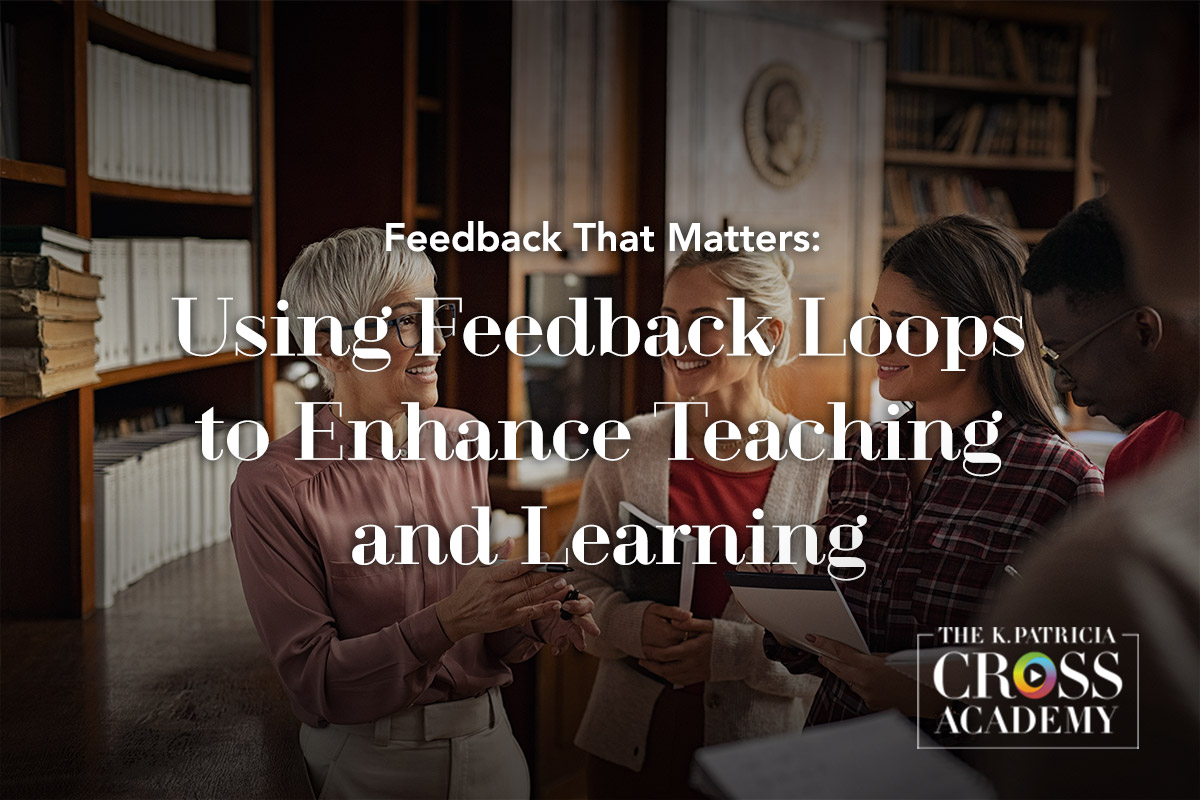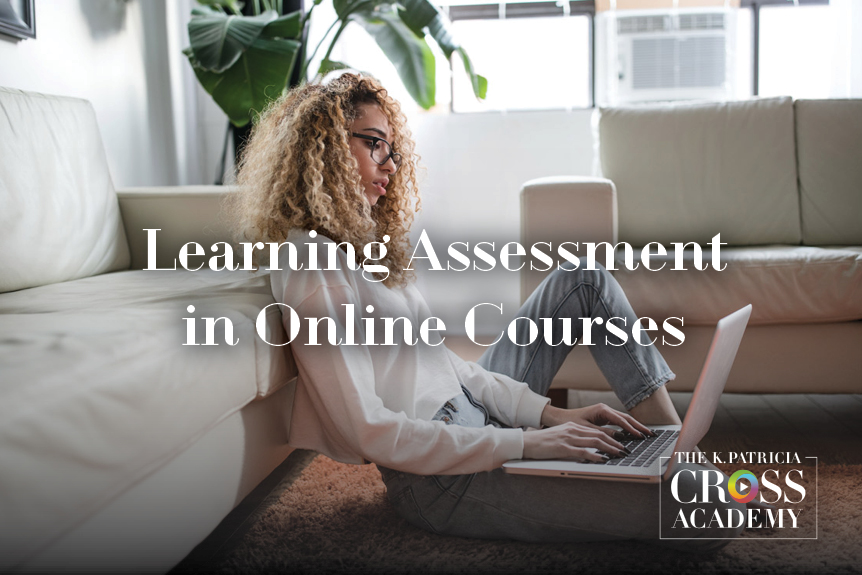
Faculty who have recently begun teaching online often ask: “How will I know that my online students are learning when I can’t see them?” The short answer to this question is assessment. At its most fundamental level, assessment is the action of appraising the quality of something. In teaching, assessment is used to appraise the knowledge, skills, attitudes, and beliefs that students have acquired as the result of learning in their courses.

When talking about assessment at the course level, we use the term “learning assessment.” When we speak of learning assessment, we mean the actions undertaken by teachers and by students to document student learning in a given course. We recognize that the term “learning assessment” has the potential to be read in different ways. Indeed, the ambiguous modifier was one of the very reasons we selected the term. For us, when we use the phrase “learning assessment,” we mean to comprise the following two meanings as one:
- Learning Assessment – This emphasis indicates that the assessment is part and parcel of the learning process. That is, participating in the assessment also helps the learning itself. This view of assessment is akin to what Wiggins (1998) calls “educative assessment.”
- Learning Assessment – This emphasis indicates an appraisal of the quality of learning. Such an appraisal can happen because the learner produces a product that may be appraised and probably graded. Results of the assessment can, therefore, be communicated to students or a host of other stakeholders or interested parties.
Thus, the goal of Learning Assessment is to determine whether actual learning outcomes match desired learning outcomes while also improving student learning in the process.
Crafting an assessment strategy that informs your teaching, fosters student learning, and provides accurate feedback and measure of student success can be a challenge. When thinking about how to assess student learning in online courses, it is important to consider two main types of assessments: formative assessments and summative assessments, both of which can be learning assessments.
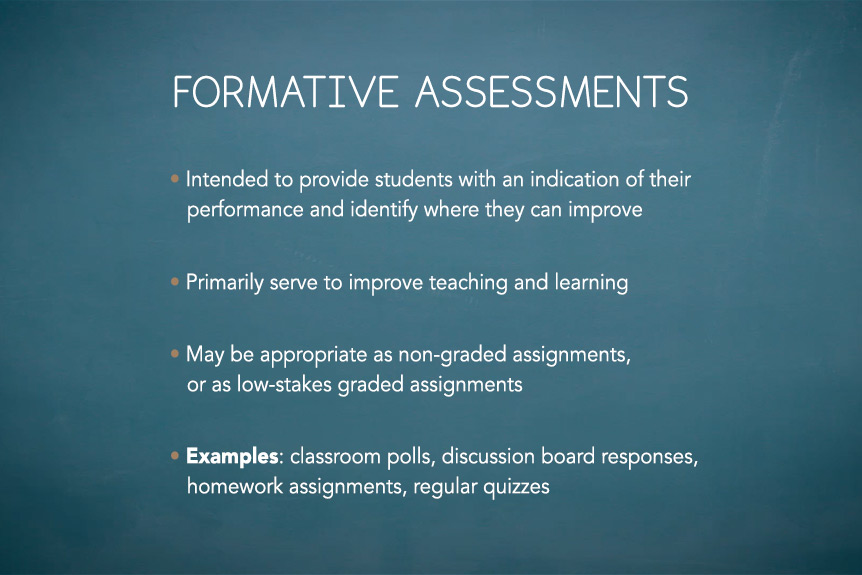
Formative Assessments
Formative assessments are intended to provide students with an indication of their performance and to give them an opportunity to improve their performance prior to receiving a final grade, either on an assignment or in a course. Formative assessment, then, is done primarily for the purpose of improving teaching and learning. Classroom Assessment Techniques by Angelo and Cross (1993) is a good resource of formative assessment techniques. Famous examples from their book are the “minute paper” and “muddiest point” techniques, which involve collecting information during or just after an instructional activity to gather insight on what students did or did not understand. Defining characteristics of Cross and Angelo’s approach to formative assessment is that the purpose for collecting data is to gain insight on what adjustments in instruction need to be made in order “to improve the quality of student learning, not to provide evidence for evaluating or grading students” (Angelo & Cross, p. 5). Some educators refer to this form of assessment as non-graded assessment or, if it is graded, it is low-stakes grading. This type of assessment can include classroom polls, discussion board responses, homework assignments, and even regular quizzes.
Another source of formative assessment activities is our Learning Assessment Techniques book. Sample techniques from this work include the following:
- Background Knowledge Probe: A Background Knowledge Probe is a short, simple, focused questionnaire that students fill out at the beginning of a course or start of a new unit that helps teachers identify the best starting point for the class as a whole.
View main video here: View Technique →
View online adaptation here:
- Individual Readiness Assurance Tests (IRATs): Individual Readiness Assurance Tests are closed-book quizzes that students complete after an out-of-class reading, video, or other homework assignments.
View main video here: View Technique →
View online adaptation here:
- Quick Write:Quick Write is a learning assessment technique where learners respond to an open-ended prompt.
View main video here: View Technique →
View online adaptation here:
- Contemporary Issues Journal: In a Contemporary Issues Journal, students look for recent events or developments in the real world that are related to their coursework, then analyze these current affairs to identify the connections to course material in entries that they write in a journal.
View main video here: View Technique →
View online adaptation here:
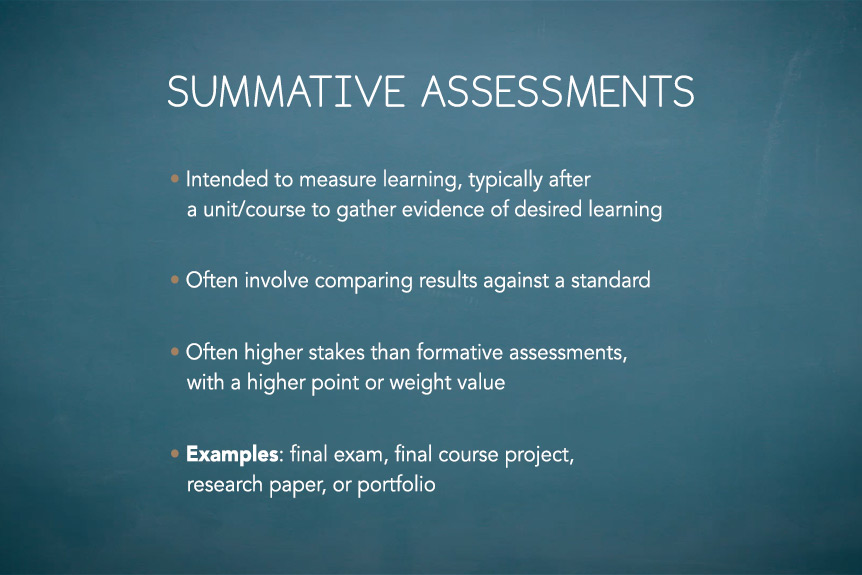
Summative Assessments
Summative assessments are intended to measure learning, typically at the end of an instructional module, unit, or course and often involving comparing results against some standard or benchmark. The purpose is to gather evidence that ensures students have accomplished the desired learning. Summative assessments are often higher stakes than formative assessments, meaning that they have a relatively high point or weight value. Examples of summative assessments include a final exam, a final course project, a research paper, or a course portfolio. Following are examples of summative assessments from our Learning Assessment Techniques book:
- Triple Jump: A Triple-Jump is a three-step technique that requires students to think through and attempt to solve a real-world problem.
- Case Studies: With Case Studies, student teams review a real-life problem scenario in depth. Team members apply course concepts to identify and evaluate alternative approaches to solving the problem.
- Class Book: For a Class Book, individual students work together to plan and ultimately submit a scholarly essay or research paper. Then all students’ papers are published together.
There are several key elements to consider as you choose a learning assessment technique, including:
- What is your purpose for assessing student learning? It is important to consider why and for whom you are collecting the data. For example, if you are conducting formative assessment to provide yourself and students with a sense of their progress, then you will want to choose a technique designed for this purpose.
- How complex of an activity you want to implement? Assessment techniques can vary from simple techniques that require minimum preparation and little effort to implement and evaluate complex techniques that involve considerable effort to employ and evaluate effectively.
- What kind of product do you want students to produce? Techniques like CATs (Classroom Assessment Techniques) or LATs (Learning Assessment Techniques) link the learning activity to the production of a learning artifact such as writing, presenting, or creating a product. The technique you select should produce the form or product that you believe will best demonstrate student learning for your course and then your discipline, as this is the product you will ultimately assess and likely grade.
Assessment is the way we college teachers can determine the effectiveness of our teaching and the quality of student learning. Our focus is on learning assessment, that is, assessment for and of learning. We can use the information we glean from our assessment efforts for a variety of purposes, including to determine for ourselves how well students in our courses are learning, to provide learners with feedback on their progress, to improve our profession through the scholarship of teaching and learning (SoTL), and to provide information to institutional and external stakeholders, but most of all to improve student learning.
Sign Up for Our Newsletter
Email us to receive information about new blog posts.
Reference:
Barkley, E. F., & Major, C. H. (2016). Learning assessment techniques: A handbook for college faculty. San Francisco: Jossey Bass/Wiley.
Suggested Citation
Barkley, E. F., & Major, C. H. (n.d.). Learning assessment in online courses. CrossCurrents. https://kpcrossacademy.ua.edu/learning-assessment-in-online-courses/
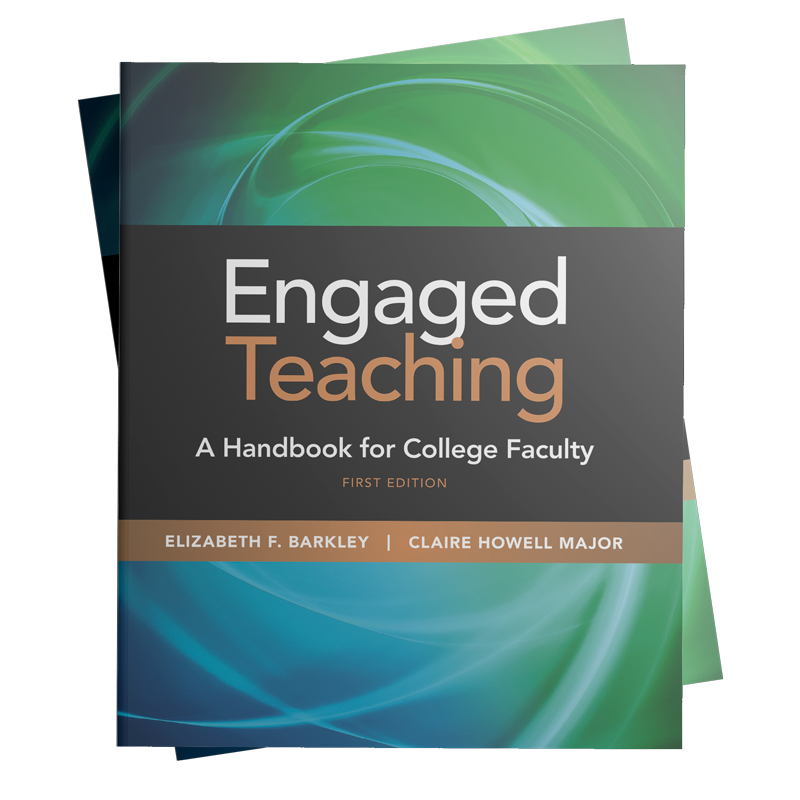
Engaged Teaching
A Handbook for College Faculty
Available now, Engaged Teaching: A Handbook for College Faculty provides college faculty with a dynamic model of what it means to be an engaged teacher and offers practical strategies and techniques for putting the model into practice.
